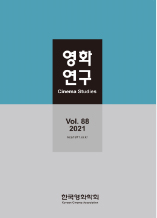- 영문명
- A Study on the Urban Space Reproduced in Jia Zhang-ke’s Film (1998-2018) Based on Henri Lefebvre’s “Urban Spatial Discourse”
- 발행기관
- 한국영화학회
- 저자명
- 왕겅이 정태수
- 간행물 정보
- 『영화연구』제88호, 207~244쪽, 전체 38쪽
- 주제분류
- 예술체육 > 예술일반
- 파일형태
- 발행일자
- 2021.06.30
7,360원
구매일시로부터 72시간 이내에 다운로드 가능합니다.
이 학술논문 정보는 (주)교보문고와 각 발행기관 사이에 저작물 이용 계약이 체결된 것으로, 교보문고를 통해 제공되고 있습니다.

국문 초록
영화는 도시에서 탄생하며 자신의 표현방식(영화적 공간)을 통해 도시를 재현한다. 도시와 영화는 이러한 친연관계가 있어서 본 논문은 앙리 르페브르(Henri Lefebvre)의 공간담론을 토대로 영화에 접근하고자 한다. 보다 구체적으로 접근할영화는 개혁 개방 이후 중국사회의 변화를 냉철하게 기록하는 중국 제6세대 대표감독인 지아장커(賈樟柯)의 12편의 장편 영화작품들이다. 지아장커 영화를 선택하는 이유는 그의 영화에 재현된 도시 공간은 르페브르의 도시적 공간담론에서 논술하는 것과 놀랄 정도의 일치성이 있기 때문이다. 특히 도시적 공간의 소외와 도시공간에 내포된 변증법적 특성은 지아장커와 르페브르의 공통적인 관심사이다. 르페브르가 도시는 소외의 온상이라고 지적하며 산업화(사물의 생산)와 탈산업화(기호적 소비)라는 두 가지 측면에서 도시적 소외에 대해 집중적으로 논의했다. 또한 그에게 있어서 도시는 정지되어 있는 공간이 아니라 유동적이고 변증법적인공간이다. 도시적 공간의 변증법적 특징에 대해 그가 ‘주변-중심’, ‘생산-소비’, ‘(재)영토화-탈 영토화’라는 세 가지 측면에 입각해 구체적으로 분석하고자 한다. 지아장커는 르페브르가 지적하는 도시적 공간이 갖고 있는 소외성과 변증법적특성을 자신의 영화적 공간으로 재현한다. 도시적 공간의 소외성의 경우, 그가 영화에서 개혁 개방 이후 도시로 유입된 농민공(農民工)과 자본주의 논리에 순응할줄 모르는 주변인(邊緣人)이라는 인물군상을 자신의 영화의 주인공을 설정함으로써 자본으로부터 나오는 도시적 소외를 그려냈다. 다른 한편, 르페브르가 지적하는 ‘주변-중심’, ‘생산-소비’, ‘(재)영토화- 탈 영토화’라는 세 가지 도시적 공간의 변증법의 경우, 그의 영화에서 농촌과 도시의 대비, 그리고 낡은 것의 해체와 새로운 것의 형성 과정을 보여주면서 도시적 공간의 ‘주변-중심’의 변증법적 관계를 그려냈다. 그리고 영화에서 도시에 있는 노동자들의 노동과정과 대중광고, 명품 브랜드를 함께 보여줌으로써 도시적 공간의 생산-소비의변증관계를 재현했다. 또한 감독이 영화에서 중국본토적인 것과 자본주의 세계화로인해 중국으로 유입된 외래 자본, 문화, 이데올로기 등 함께 대비적으로 보여줌으로써 도시적 공간 속에 끊임없는 (재)영토화- 탈 영토화의 변증법적 관계를 그려냈다. 이처럼 르페브르와 지아장커가 이러한 비슷한 관심사가 있어서 본 논문에서는르페브르의 도시적 공간담론을 바탕으로 지아장커 영화에 접근함으로써 개혁 개방 이후 중국 도시 공간 표상변화에 대해 살펴보고자 한다
영문 초록
Film are born in cities and reproduce the city in their own way. Because cities and films are related to each other, this paper seeks to approach films based on Henri Lefebvre’s Urban space discourse. More specifically, the films will be 12 feature films by China’s sixth-generation representative director, Jia Zhang-ke’s films who records changes in Chinese society in a cool manner after the reform and opening. The reason for choosing Jia Zhang-ke’s film is that the urban space reproduced in his film is surprisingly consistent with Lefebvre’s urban spatial discourse. In particular, the alienation of urban space and dialectical characteristics implicit in urban space are common interests of Jia Zhang-ke and Lefebvre. Lefebvre pointed out that cities are hotbeds of alienation and intensively discussed urban alienation in terms of two values: industrialization (production of things) and deindustrialization (symbolic consumption). Also, for him, the city is not a stationary space, a fluid and dialectical space. He specifically analyzed the dialectical characteristics of urban space based on three aspects: “ambient-centered”, “production-consumption”, and “re-territorialization-de- territorialization.” Jia Zhang-ke recreated the alienation and dialectical characteristics of the urban space pointed out by Lefebvre into his cinematic space. In the case of urban space alienation, he recreated urban alienation from capital by setting the main characters of his film, “farmers-turned migrant workers” and “the marginal person” who were not compliant with capitalist logic after the opening of the reform. On the other hand, in the case of the dialectics of three urban spaces, which Lefebvre points out, “periphery-centre”, “production-consumption”, and “reterritorialization- de-territorialization” his film depicts the dialectical relationship of urban space by showing rural and urban contrasts, and the dismantling of old and forming new. And the film recreates the dialectical relationship between production and consumption of urban space by showing the labor process of workers in the city, mass advertising, and luxury brands together. In addition, the film depicts the dialectical relationship of mainland China and foreign capital, culture, and ideology that flowed into China due to capitalist globalization, depicting a constant re-territorialization-de-territorialization in urban space. As Lefebvre and Jia Zhang-ke have similar interests, in this paper, would like to attempt in-depth analysis by approaching Jia Zhang-ke’s film based on Lefebvre’s urban spatial discourse.
목차
1. 들어가는 말
2. 앙리 르페브르의 도시적 공간담론
3. 지아장커 영화에 재현된 도시 공간
4. 나오는 말
키워드
해당간행물 수록 논문
- 토드 헤인즈의 <캐롤(Carol)>의 영화적 공간
- 비평적 창작으로서의 각색
- 코로나19와 영화제의 미래
- 복수의 다층성과 사적 복수의 정당성
- 앙리 르페브르의 도시적 공간담론을 통해 본 지아장커(賈樟柯) 영화에 재현된 도시 공간 (1998-2018)
- <세브린느>
- 권역 단위의 국제공동제작이 유럽 영화시장에 미치는 영향과 의의
- 한국 시네마스코프 전환 시기의 영화 <여사장>의 스타일 분석
- 슬로우 시네마의 에코-슬로우 미학과 그 비의식적 경험
- 비대면 영화교육에 대한 전망
- 아날로그 미디어 노스탤지어와 디지털 영화
- 영화연구 게재논문 투고, 심사(수정), 게재확정일 외
- 게토영화와 갱스터
- 언택트 시대, 영화제의 변화상과 새로운 가능성
- 앙드레 바쟁의 영상 존재론과 허우샤오시엔 영화의 롱 테이크 유사성
- 혼돈의 사회와 도시의 리듬
- 영화연구 제88호 목차
참고문헌
관련논문
예술체육 > 예술일반분야 BEST
- 생성형 AI 도구와 디자이너의 협업 프로세스 개발 - 이미지를 통한 아이디어 확산에서 고해상도 렌더링까지
- 영화 [올드보이]와 소포클레스 「오이디푸스 왕」의 상동성 연구
- ‘일과 삶의 균형(Work-Life Balance)’ 척도 개발을 위한 연구
예술체육 > 예술일반분야 NEW
- Z세대 생활체육 동호인들의 SNS 중독 경향성과 불안정 성인애착이 완벽주의적 자기제시 및 우울에 미치는 영향
- 즐거움과 몰입을 통한 수익성 기대가 NFT 구매 의도에 미치는 매개효과 분석: UTAUT2와 합리적 무관심(RI)을 중심으로
- 생태체험이 청소년의 자연친밀감, 환경태도, 환경행동의도에 미치는 영향
최근 이용한 논문
교보eBook 첫 방문을 환영 합니다!

신규가입 혜택 지급이 완료 되었습니다.
바로 사용 가능한 교보e캐시 1,000원 (유효기간 7일)
지금 바로 교보eBook의 다양한 콘텐츠를 이용해 보세요!



